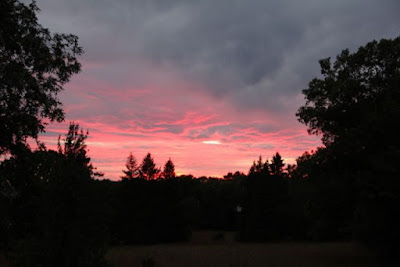I suppose it makes sense to have international
Bat Week the week before
Halloween.
Minnesota is home to seven species of bats, about half of whom hibernate in Winter while the other half migrates south. Here's a
link to eleven facts about bats, including information on white-nose syndrome.
 |
new bat house
|
On Summer evenings, we often see bats flying and feeding over the wet spot in our back yard. For years we had a bat house in an oak tree next to our deck. Eventually, the branch holding the bat house died, fell down, and took the bat house with it. The Son-In-Law person built a new bat house (the old one had been "store boughten") and we installed it where it should be more visible to our furry, flying friends. One of these days I'll stroll up the hill and see if there are any signs under the house that bats have moved in, now that it's been up for a couple or three years.
 |
"new" bat house after weathering
|
This past Summer, a
new (to Minnesota) species of bat was discovered in Arden Hills. That will make eight species but I don't know how many times the new species will have to be seen before it counts as a Minnesotan. Shortly after we moved into our house, we discovered a bat. It was flying around the bedroom ceiling and the downstairs family room. I decided that a firearm might do more harm than good and retrieved a large fishing net from the garage while the Better Half monitored the invader's location. After a few missed swipes, the bat was entangled in the net, transported outside and released. At least that's how I recall my brave response to the situation. I suspect the bat was considerably more scared than the humans.
How to Love Bats
Begin in a cave.
Listen to the floor boil with rodents, insects.
Weep for the pups that have fallen. Later,
you’ll fly the narrow passages of those bones,
but for now —
open your mouth, out will fly names
like Pipistrelle, Desmodus, Tadarida. Then,
listen for a frequency
lower than the seep of water, higher
than an ice planet hibernating
beyond a glacier of Time.
Visit op shops. Hide in their closets.
Breathe in the scales and dust
of clothes left hanging. To the underwear
and to the crumbled black silks — well,
give them your imagination
and plenty of line, also a night of gentle wind.
By now your fingers should have
touched petals open. You should have been dreaming
each night of anthers and of giving
to their furred beauty
your nectar-loving tongue. But also,
your tongue should have been practising the cold
of a slippery, frog-filled pond.
Go down on your elbows and knees.
You’ll need a spieliologist’s desire for rebirth
and a miner’s paranoia of gases —
but try to find within yourself
the scent of a bat-loving flower.
Read books on pogroms. Never trust an owl.
Its face is the biography of propaganda.
Never trust a hawk. See its solutions
in the fur and bones of regurgitated pellets.
And have you considered the smoke
yet from a moving train? You can start
half an hour before sunset,
but make sure the journey is long, uninterrupted
and that you never discover
the faces of those Trans-Siberian exiles.
Spend time in the folds of curtains.
Seek out boarding-school cloakrooms.
Practise the gymnastics of web umbrellas.
Are you
floating yet, thought-light,
without a keel on your breastbone?
Then, meditate on your bones as piccolos,
on mastering the thermals
beyond the tremolo; reverberations
beyond the lexical.
Become adept
at describing the spectacles of the echo —
but don’t watch dark clouds
passing across the moon. This may lead you
to fetishes and cults that worship false gods
by lapping up bowls of blood from a tomb.
Practise echo-locating aerodromes,
stamens. Send out rippling octaves
into the fossils of dank caves —
then edit these soundtracks
with a metronome of dripping rocks, heartbeats
and with a continuous, high-scaled wondering
about the evolution of your own mind.
But look, I must tell you — these instructions
are no manual. Months of practice
may still only win you appreciation
of the acoustical moth,
hatred of the hawk and owl. You may need
to observe further the floating black host
through the hills.
********************************************
Thanks for visiting. Come again when you can.
Please be
kind
to each other while you can.


























